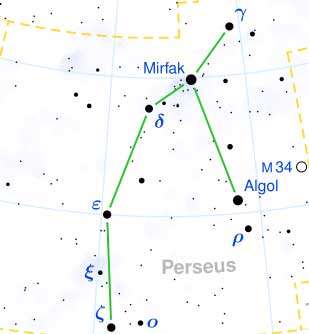May 2, 2012 report
Cairo Calendar shows Egyptians discovered binary Algol first

(Phys.org) -- Algol, aka the Demon Star, is actually a binary star in the Perseus constellation, and has been the subject of speculation for hundreds of years. Now a group of Finnish researchers propose that the peculiar behavior of Algol was first noted by the Egyptians some 3200 years ago. They suggest, as they describe in their paper uploaded to the preprint server arXiv, that a document known as the Cairo Calendar, shows that not only did the Egyptians know about Algol, but that their observations can be used to further explain the erratic behavior of the binary seen today.
What makes Algol so interesting is the fact that it brightens and dims every 2.867 days, a phenomenon first described in semi-modern western astronomy by John Goodricke, who wrote about what he saw with the naked eye back in 1783. And while neither he nor the ancient Egyptians could have known that the dimming was caused by one of the binary stars passing in front of the other, it’s clear now that there is something else at play as well, because the dimming takes on other characteristics periodically as well and it might even be changing over time; and the team from Helsinki believe some of the explanation for it can be found in an ancient document known as the Cairo Calendar.
Study of the ancient Egyptians has shown that they were very nearly obsessive about studying the stars, apparently believing that doing so could help predict future events. Astronomers from that time took note of where stars were in relation to one another and of course any unusual activity, such as brightening and dimming on a regular basis. They made notes of such observations in documents that took on the characteristics of calendars as they tracked the days and planned for what they thought might come next. One such document, called the Cairo Calendar managed to survive over the thousands of years since it was created and the team from Finland believe one of the observations recorded on it is the brightening and dimming of the Algol binary.
There’s one hitch though, the data from the Cairo Calendar describes the binary period as 2.85 days; ever so slightly less than the 2.867 days now observed. The team doesn’t believe this difference is due to error, they think it’s because the period has changed over time, and that they say, gives credence to the theory that the Algol binary is actually a three star system as new research has been suggesting. Thus it seems, the Egyptian data from so long ago is now able to support research being carried out all these thousands of years later.
More information: arxiv.org/abs/1204.6206
© 2012 Phys.Org

















